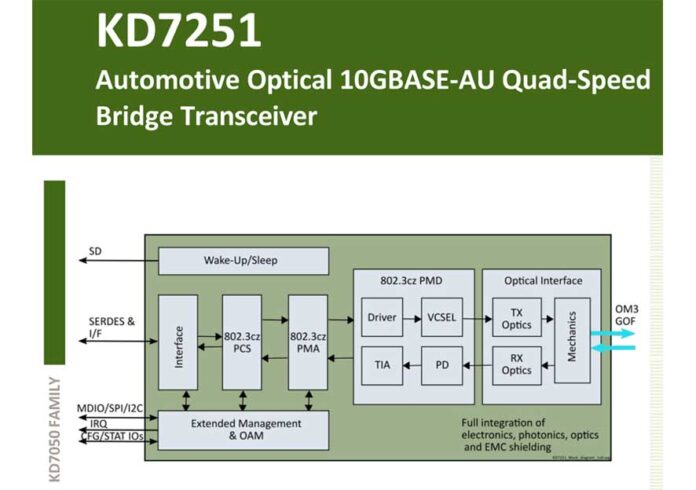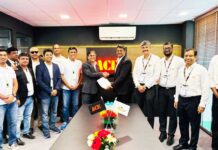
KD, a fabless semiconductor company, has announced a strategic collaboration with ZF Group, a global technology leader based in Germany, to integrate KD’s KD7251 transceiver into ZF’s high-performance ProAI ECU. This partnership marks a significant milestone in bringing optical multigigabit communication to next-generation vehicle architectures.
The KD7251 is the first optical transceiver designed to support data transmission over automotive-grade optical fibers in compliance with the IEEE 802.3cz standard. Its integration into ZF’s ProAI platform enhances high-speed connectivity capabilities for advanced in-vehicle systems.
Oliver Briemle, Head of Cross-Domain Computing at ZF, emphasized the importance of this advancement: “At ZF, we see ultra-fast data transmission as a critical enabler for the electrical systems of tomorrow’s vehicles. This technology supports both short- and long-range data links—up to 40 meters—making it suitable for a wide range of applications in passenger cars and commercial vehicles. Our tests confirm that optical multigigabit Ethernet is a robust, future-ready solution for automotive data communication.”
Solving Data Transmission Challenges in Vehicles
The implementation of KD’s high-speed connectivity over fiber optics by ZF Group is a major milestone of converting the IEEE Std 802.3cz specifications into real products and applications. Carlos Pardo, CEO and Co-founder of KD, confirmed strongly: “At KD, we’re excited to contribute to this evolution with our automotive optical transceiver KD7251, which supports the IEEE Std 802.3cz standard and enables multigigabit communications with multi-mode glass optical fiber. This latest implementation in mainstream automotive networking further verifies our vision and path of utilizing fiber optics communications to solve connectivity challenges in harsh environments.”
Enabling Multigigabit Communications in Automotive Systems
KD’s latest transceiver KD7251 implements the BASE-AU physical layers and is compliant with the IEEE Std 802.3cz™ standard specification for automotive multigigabit optical communications over glass optical fiber links. It is a single-chip solution with on-chip optical interface, supporting 2.5, 5, and 10 Gb/s. The transceiver includes bridging functionalities to enable the connectivity of MIPI sensors, as cameras and radar (CSI-2®), displays (DSI-2℠), or AI processors (PCIe®) in the vehicle.
The KD7251 reaches 40 meters with 4 inline connectors over standard duplex OM3 multi-mode glass optical fiber (MM-GOF) at 10 Gb/s in the whole temperature range. The same cables and connectors will be reused for higher bitrates (25, 50 Gb/s and higher in the future). With its integrated EMC shielding, the KD7251 transceiver guarantees the highest component-level EMC compliance without the need for any external additions. This translates into a port with a small PCB area and a reduced Bill of Materials (BOM), with no need for ESD protections, common mode chokes, EMI filters or DC blocks.
As native automotive part, the KD7251 supports MACsec, ASIL-B FuSa, TSN, Wake-up & Sleep, OAM, and dependability functions. Thus, the transceiver enables a broad range of use cases with optical technology, such as multigigabit Ethernet backbone, zonal gateway connectivity, smart antenna link, and connectivity for radars, cameras, lidar, displays, and high-performance computing units.
In addition, KD will showcase its latest advancements in optical multigigabit connectivity at several upcoming industry events:
- 2025 TSMC Europe Technology Symposium – May 27, Amsterdam, Netherlands
- AutoSens – June 10–12, Detroit, MI, USA
- Automotive Ethernet Tech Days (Nikkei) – July 3–4, Kyoto, Japan
These demonstrations will highlight KD’s ongoing innovation in high-speed automotive data transmission.









